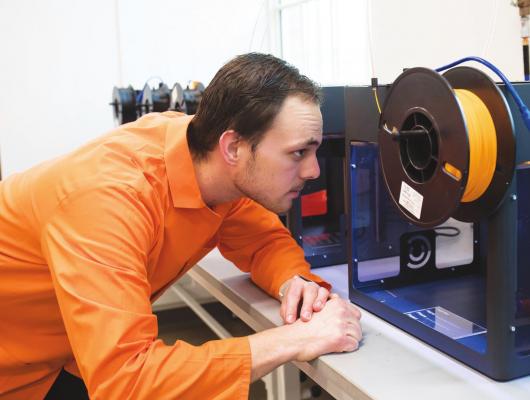Students manufacture masks for donation
STILLWATER — A team from Oklahoma State University’s College of Engineering, Architecture and Technology’s (CEAT) ENDEAVOR lab is prototyping and manufacturing protective masks and face shields for donation.
The team, which includes students, faculty and staff, will donate them to first responders in the Stillwater community and medical professionals at Stillwater Medical Center and the Family Medicine Residency Program at AllianceHealth Durant in Durant, Oklahoma.
Electrical engineering technology senior Killian Bussey, who works at ENDEAVOR, was initially inspired by a Twitter post from Italy, where volunteers made protective masks for medical professionals and first responders. He talked to his supervisors and fellow electrical engineering technology student Jordan Fogg about the idea and the team was soon at work.
“I believe making the masks could have a fantastic impact on the community,” Bussey said. “The entire team here really cares about what we are doing, and wants to help as many people as possible.”
Since then, the team at ENDEAVOR has been running 20 3D printers around the clock. The ENDEAVOR lab has a demand for about 120 face shields a day and has asked Edmon Low Creative Studios — a studio with 3D printing capabilities inside the Edmon Low Library — and the OSU College of Education, Health, Aviation and Human Sciences to assist with the project.
To create the prototypes, the team explored different mask designs and made modifications to improve performance and protection.
“We throw out different ideas to each other, and then we print the mask or face shield, try it on and alter what we think should be altered in the STL files [a common 3D printing file format] to improve things like air flow and the head pieces that hold the face shields,” Bussey said.
During prototyping the team looks at different materials to ensure user comfort. They factor in the products reusability, address supply chain issues and provide alternatives for filter materials and face shield attachments.
“We try out different materials on the masks to see what works better, like thermoplastic polyurethane versus polylactic acid material,” Bussey said.
“We are making roughly 20 filtration type mask prototypes so individuals can wear and test them and determine which type will best serve them in their work environment,” said Dr. Brad Rowland, ENDEAVOR operations manager. “Once we know which prototype is preferred, we will mass print them.”
Rowland said the prototypes will use N90- or N95-rated filter material or High Efficiency Particulate Air (HEPA) filters. N90 or N95 masks are commonly used by health care professionals and filter out 90 to 95 percent of suspended air particles, respectively.
HEPA filters can filter out 99.97 percent of airborne particles. These masks can aid in the protection of individuals caring for patients.
“You could cut one N95 mask or HEPA filter into several small squares and place these into the air filtration portion of our mask. By doing this you can get several uses out of one mask or HEPA filter,” Rowland said.
The ENDEAVOR team is also working on creating headbands to connect to face shields, as well as 3D-printed mounting devices that can be clipped on to repurposed transparent sheets, turning them into face shields.
“We are printing small things that can turn everyday items into protection,” Bussey said. “There is a shortage of elastic bands for face masks so we have developed a solution that uses household rubber bands and a small 3-D printed piece to help secure the filtration mask to your face.”
After the team creates prototypes, they send the designs to Dr. Paul Tikalsky, CEAT dean and professor, who then receives design feedback from industry professionals. Tikalsky said the team also is sending filtration masks to the OSU Center for Health Sciences for evaluation.
“We have been working with the Stillwater Medical Center infection control team to improve our designs,” Tikalsky said. “For example, they suggested that our face shield bands have a covered top for extra protection and we have made that adjustment and are going into production with the adjusted design.”
The cooperation extends further, as well. OSU and the ENDEAVOR lab are part of a national consortium of universities that are brainstorming and designing solutions to the most immediate pandemic challenges.
“Dr. Brad Rowland and Dr. Hitesh Vora [assistant professor in the Division of Engineering Technology] have trained extraordinary engineering and engineering technology students to create open source solutions that can be rapidly adapted to meet the needs of the pandemic,” Tikalsky said. “I am proud that CEAT can contribute to the safety of those on the front lines.”
Bussey believes using ENDEAVOR to provide these masks demonstrates not just the lab’s 3D printing capabilities, but also OSU’s service-oriented culture and land-grant mission.
“Now that we are done prototyping, we will release our files to other colleges, technology centers and individuals with 3-D printing capabilities so that they can help out with the shortage of face shields as well,” Bussey said.
The weight of the situation is not lost on Rowland.
“This is an extraordinary time, so we are trying to do extraordinary things,” he said.


